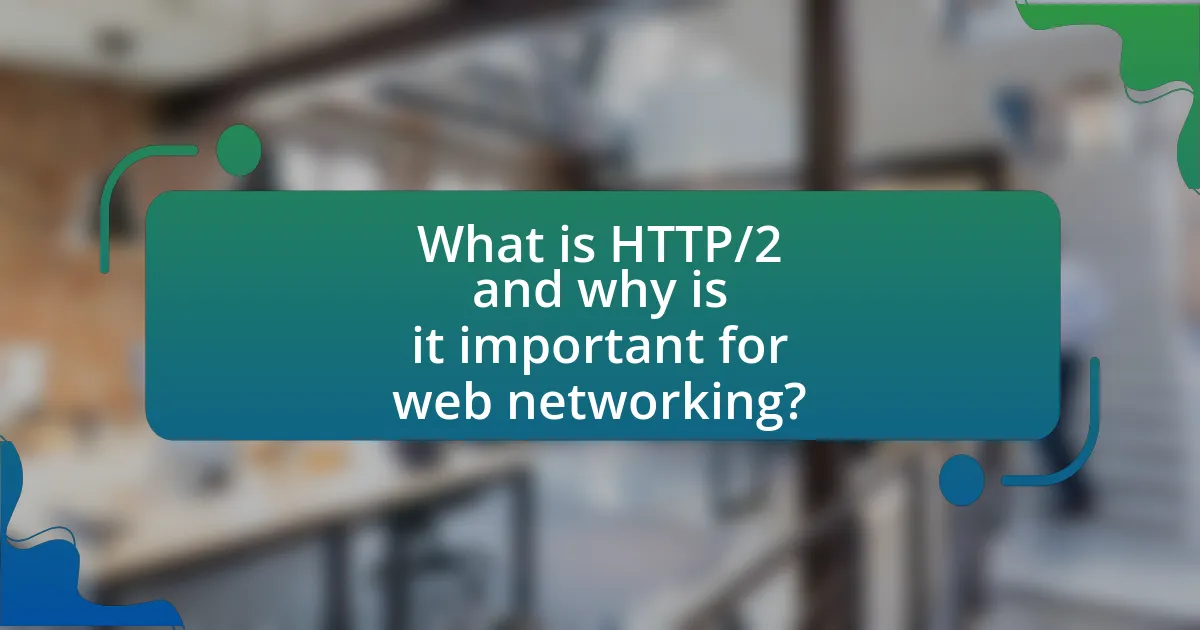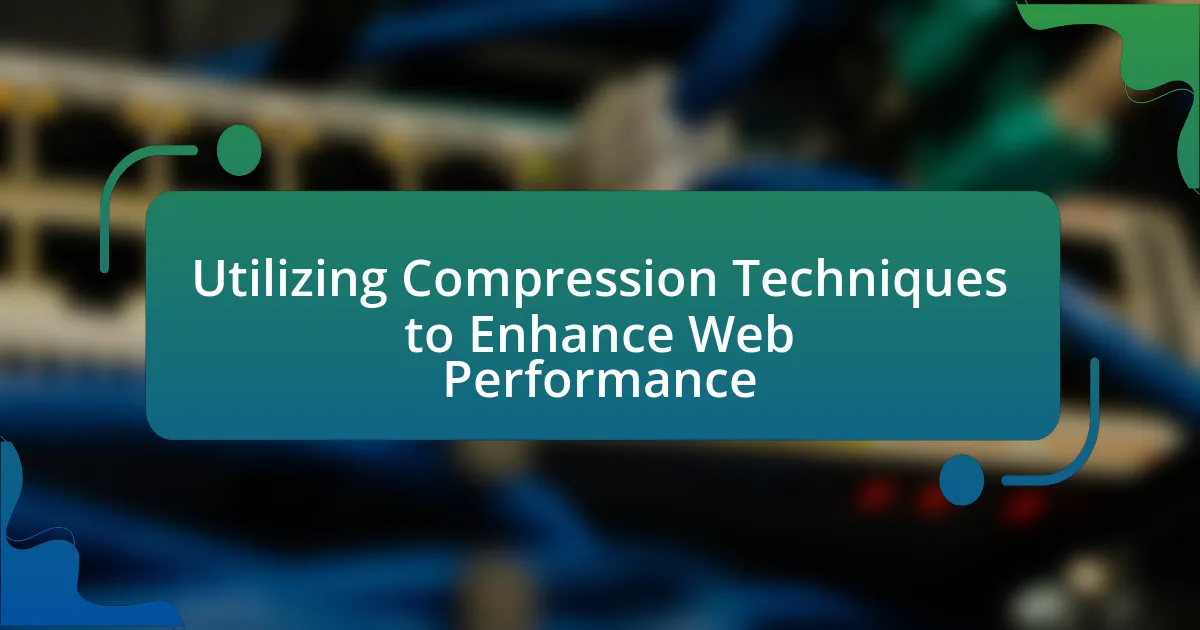HTTP/2 is a significant advancement in web networking, designed to enhance the performance of web communications through features such as multiplexing, header compression, and server push. This protocol allows multiple simultaneous requests and responses over a single connection, effectively reducing latency and improving page load times by up to 50% compared to HTTP/1.1. The article explores the key differences between HTTP/2 and its predecessor, the core principles behind its design, and the specific features that contribute to improved web performance. Additionally, it addresses the challenges HTTP/2 resolves, offers implementation guidance for organizations, and discusses future trends, including the transition to HTTP/3.

What is HTTP/2 and why is it important for web networking?
HTTP/2 is a major revision of the Hypertext Transfer Protocol, designed to improve the performance of web communications. It is important for web networking because it allows multiple simultaneous requests and responses over a single connection, reducing latency and improving page load times. This is achieved through features like multiplexing, header compression, and server push, which collectively enhance the efficiency of data transfer. According to Google, HTTP/2 can reduce page load times by up to 50% compared to its predecessor, HTTP/1.1, demonstrating its significant impact on web performance.
How does HTTP/2 differ from its predecessor, HTTP/1.1?
HTTP/2 differs from its predecessor, HTTP/1.1, primarily through its use of multiplexing, header compression, and binary framing. Multiplexing allows multiple requests and responses to be sent simultaneously over a single connection, reducing latency and improving loading times. In contrast, HTTP/1.1 requires multiple connections to achieve similar performance, leading to increased overhead. Header compression in HTTP/2 minimizes the size of HTTP headers, which can significantly reduce the amount of data transmitted, while HTTP/1.1 sends headers in plain text, resulting in larger payloads. Additionally, HTTP/2 employs a binary framing layer, which enhances efficiency and reduces complexity compared to the textual format used in HTTP/1.1. These advancements collectively enable faster and more efficient web networking.
What are the key features that distinguish HTTP/2?
HTTP/2 is distinguished by several key features that enhance web performance. Firstly, it introduces multiplexing, allowing multiple requests and responses to be sent simultaneously over a single connection, which reduces latency. Secondly, HTTP/2 employs header compression through HPACK, minimizing the overhead of HTTP headers and improving efficiency. Thirdly, it supports server push, enabling servers to send resources to clients proactively, further speeding up page load times. Lastly, HTTP/2 maintains a binary protocol format instead of the textual format used in HTTP/1.1, which improves parsing efficiency and reduces errors. These features collectively contribute to faster and more efficient web networking.
How do these features enhance web performance?
HTTP/2 features enhance web performance by enabling multiplexing, header compression, and server push. Multiplexing allows multiple requests and responses to be sent simultaneously over a single connection, reducing latency and improving load times. Header compression minimizes the size of HTTP headers, which decreases the amount of data transmitted and speeds up communication. Server push enables servers to send resources to the client proactively, anticipating the client’s needs and further reducing load times. These enhancements lead to a more efficient use of network resources and a faster user experience.
What are the core principles behind HTTP/2’s design?
The core principles behind HTTP/2’s design include multiplexing, header compression, and server push. Multiplexing allows multiple streams of data to be sent simultaneously over a single connection, reducing latency and improving resource utilization. Header compression minimizes the overhead of HTTP headers, which enhances performance by decreasing the amount of data transmitted. Server push enables the server to send resources to the client proactively, anticipating the client’s needs and further speeding up page load times. These principles collectively aim to enhance the efficiency and speed of web communication, addressing the limitations of HTTP/1.1.
How does multiplexing improve resource loading?
Multiplexing improves resource loading by allowing multiple requests and responses to be sent simultaneously over a single connection. This reduces latency and improves the overall efficiency of data transfer, as it eliminates the need for multiple TCP connections, which can be slow to establish and manage. In HTTP/2, multiplexing enables the prioritization of requests, ensuring that critical resources are loaded first, further enhancing the user experience. Studies have shown that websites utilizing HTTP/2 with multiplexing can achieve faster load times compared to those using HTTP/1.1, where requests are processed sequentially.
What role does header compression play in HTTP/2?
Header compression in HTTP/2 significantly reduces the size of HTTP headers, enhancing the efficiency of data transmission. This is achieved through the HPACK compression format, which minimizes redundancy by encoding header fields and their values, allowing for faster loading times and reduced bandwidth usage. For instance, HTTP/2 can compress headers by up to 80% compared to HTTP/1.1, which directly contributes to improved performance in web networking. This compression mechanism is crucial for optimizing resource utilization and accelerating page load speeds, thereby facilitating a more responsive user experience.
What challenges does HTTP/2 address in web networking?
HTTP/2 addresses several challenges in web networking, primarily by improving performance and efficiency. It mitigates the issue of head-of-line blocking, which occurs in HTTP/1.1 when a single slow request can delay all subsequent requests. HTTP/2 introduces multiplexing, allowing multiple requests and responses to be sent simultaneously over a single connection, thus eliminating this bottleneck. Additionally, HTTP/2 reduces latency through header compression, which minimizes the overhead of transmitting redundant header data. According to Google, these enhancements can lead to faster page load times and a more responsive user experience, validating the effectiveness of HTTP/2 in addressing these critical challenges.
How does HTTP/2 reduce latency in web applications?
HTTP/2 reduces latency in web applications primarily through multiplexing, which allows multiple requests and responses to be sent simultaneously over a single connection. This eliminates the need for multiple TCP connections, reducing the overhead associated with establishing and maintaining these connections. Additionally, HTTP/2 employs header compression, which minimizes the size of the data being transmitted, further decreasing the time it takes for web pages to load. These features collectively enhance the efficiency of data transfer, leading to faster load times and improved user experience in web applications.
What impact does HTTP/2 have on server resource utilization?
HTTP/2 significantly reduces server resource utilization compared to its predecessor, HTTP/1.1. This reduction is primarily due to features such as multiplexing, which allows multiple requests and responses to be sent simultaneously over a single connection, minimizing the overhead associated with establishing multiple connections. Additionally, HTTP/2 employs header compression, which decreases the amount of data transmitted, further lowering bandwidth usage and server load. Studies have shown that these optimizations can lead to a reduction in CPU usage by up to 50% and improved response times, enhancing overall server efficiency.

How can organizations leverage HTTP/2 for better performance?
Organizations can leverage HTTP/2 for better performance by utilizing its multiplexing feature, which allows multiple requests and responses to be sent simultaneously over a single connection. This reduces latency and improves loading times, as it eliminates the need for multiple TCP connections. Additionally, organizations can implement server push, enabling servers to send resources to clients proactively, further enhancing page load speed. According to Google, websites using HTTP/2 can experience up to 30% faster load times compared to those using HTTP/1.1, demonstrating the significant performance benefits of adopting this protocol.
What steps are necessary to implement HTTP/2 on a web server?
To implement HTTP/2 on a web server, the following steps are necessary: first, ensure that the web server software supports HTTP/2, as most modern servers like Apache, Nginx, and IIS do. Next, enable the HTTP/2 protocol in the server configuration files; for example, in Apache, this involves adding “Protocols h2 http/1.1” to the configuration. Then, ensure that the server is using TLS, as HTTP/2 is typically implemented over HTTPS for security reasons. Finally, restart the web server to apply the changes. These steps are validated by the widespread adoption of HTTP/2 in web technologies, as outlined in the Internet Engineering Task Force (IETF) RFC 7540, which specifies the protocol’s requirements and benefits.
What server configurations are required for HTTP/2?
To enable HTTP/2, servers must support TLS (Transport Layer Security) for secure connections, as most browsers require it for HTTP/2. Additionally, the server must be configured to use ALPN (Application-Layer Protocol Negotiation) to negotiate the protocol version during the TLS handshake. Furthermore, server software must be updated to a version that includes HTTP/2 support, such as Apache 2.4.17 or later, Nginx 1.9.5 or later, or Microsoft IIS 10.0. These configurations ensure that the server can handle multiplexing, header compression, and other features unique to HTTP/2, enhancing web performance.
How can developers optimize their applications for HTTP/2?
Developers can optimize their applications for HTTP/2 by implementing multiplexing, header compression, and prioritization of requests. Multiplexing allows multiple requests and responses to be sent simultaneously over a single connection, reducing latency and improving load times. Header compression minimizes the size of HTTP headers, which decreases the amount of data transmitted and speeds up communication. Prioritization enables developers to specify the importance of different requests, ensuring that critical resources are loaded first, enhancing user experience. These optimizations leverage the inherent features of HTTP/2, leading to more efficient data transfer and improved performance for web applications.
What tools and resources are available for testing HTTP/2 performance?
Tools and resources available for testing HTTP/2 performance include web performance testing tools like Google Lighthouse, which evaluates page load speed and HTTP/2 features, and WebPageTest, which provides detailed performance metrics for HTTP/2 connections. Additionally, tools such as curl and h2load allow developers to simulate HTTP/2 requests and measure response times. These tools are widely recognized in the industry for their accuracy and ability to provide insights into HTTP/2 performance, making them essential for optimizing web networking.
How can performance metrics be measured effectively?
Performance metrics can be measured effectively by utilizing specific tools and methodologies that capture relevant data accurately. Tools such as Google Lighthouse, WebPageTest, and performance monitoring solutions like New Relic provide insights into load times, resource utilization, and user experience metrics. For instance, Google Lighthouse evaluates performance based on metrics like First Contentful Paint and Time to Interactive, which are critical for understanding how quickly a webpage becomes usable. Additionally, employing A/B testing can help compare different configurations or optimizations to determine their impact on performance metrics. These methods ensure that performance measurements are not only precise but also actionable, allowing for continuous improvement in web networking strategies.
What common pitfalls should be avoided during implementation?
Common pitfalls to avoid during the implementation of HTTP/2 include neglecting proper server configuration, failing to optimize resource prioritization, and overlooking the importance of testing across different browsers and devices. Proper server configuration is crucial because misconfigurations can lead to performance degradation; for instance, not enabling HTTP/2 on the server can prevent users from experiencing its benefits. Resource prioritization is essential as HTTP/2 allows multiplexing, which means that prioritizing critical resources can significantly enhance loading times. Additionally, testing across various browsers and devices is vital since not all support HTTP/2 equally, and overlooking this can result in inconsistent user experiences.

What are the future trends and considerations for HTTP/2?
Future trends for HTTP/2 include increased adoption of multiplexing and header compression, which enhance performance by allowing multiple requests and responses to be sent simultaneously over a single connection. As web applications become more complex, the need for efficient resource loading will drive further optimization of these features. Additionally, considerations for security will grow, as HTTP/2 is often used in conjunction with TLS, necessitating ongoing improvements in encryption protocols to protect user data. The rise of mobile and IoT devices will also influence HTTP/2’s evolution, as these platforms require lightweight and efficient communication methods to handle varying network conditions.
How is HTTP/2 evolving with the introduction of HTTP/3?
HTTP/2 is evolving with the introduction of HTTP/3 by transitioning from a TCP-based transport protocol to a QUIC-based transport protocol, which enhances performance and security. HTTP/3 utilizes multiplexing and eliminates head-of-line blocking, allowing multiple streams of data to be sent simultaneously without waiting for others to complete, thus improving loading times. This evolution is supported by the fact that QUIC, developed by Google, integrates TLS 1.3 for improved security and faster connection establishment, reducing latency compared to HTTP/2’s reliance on TCP.
What advantages does HTTP/3 offer over HTTP/2?
HTTP/3 offers several advantages over HTTP/2, primarily through its use of QUIC as a transport protocol. QUIC reduces latency by enabling faster connection establishment and improved congestion control, which leads to quicker page loads. Additionally, HTTP/3 supports multiplexing without head-of-line blocking, allowing multiple streams of data to be sent simultaneously without waiting for others to complete. This is a significant improvement over HTTP/2, where a single lost packet can delay all streams. Furthermore, HTTP/3 enhances security by integrating TLS 1.3 directly into the protocol, providing better encryption and faster handshakes. These features collectively contribute to a more efficient and responsive web experience.
How can organizations prepare for the transition to HTTP/3?
Organizations can prepare for the transition to HTTP/3 by updating their infrastructure to support QUIC, the underlying transport protocol of HTTP/3. This involves ensuring that servers, load balancers, and firewalls are compatible with QUIC, as HTTP/3 operates over UDP rather than TCP, which requires different handling of network traffic. Additionally, organizations should conduct thorough testing of their applications to identify any compatibility issues with HTTP/3 and implement necessary adjustments. According to a report by Cloudflare, HTTP/3 can significantly reduce latency and improve loading times, making it essential for organizations to adopt this protocol to enhance user experience and performance.
What best practices should be followed when using HTTP/2?
When using HTTP/2, best practices include enabling server push, optimizing resource prioritization, and minimizing latency. Enabling server push allows the server to send resources to the client proactively, reducing load times. Optimizing resource prioritization ensures that critical resources are loaded first, improving user experience. Minimizing latency can be achieved by reducing the number of round trips required for resource fetching, which is essential for the performance benefits of HTTP/2. These practices are supported by the HTTP/2 specification, which emphasizes multiplexing and header compression to enhance efficiency and speed in web networking.
How can developers ensure compatibility with older browsers?
Developers can ensure compatibility with older browsers by using feature detection and progressive enhancement techniques. Feature detection allows developers to check if a browser supports specific features before using them, enabling fallback options for unsupported browsers. Progressive enhancement focuses on delivering a basic experience to all users while providing advanced features to those with modern browsers. For instance, developers can utilize libraries like Modernizr for feature detection and implement polyfills to add support for newer functionalities in older browsers. This approach is validated by the fact that according to Can I Use, many users still access the web through older browser versions, making compatibility essential for a broader audience reach.
What strategies can enhance security while using HTTP/2?
To enhance security while using HTTP/2, implementing Transport Layer Security (TLS) is essential, as it encrypts data in transit and protects against eavesdropping and man-in-the-middle attacks. Additionally, utilizing HTTP Strict Transport Security (HSTS) ensures that browsers only connect to the server over HTTPS, mitigating the risk of downgrade attacks. Regularly updating server software and libraries to patch vulnerabilities is crucial, as evidenced by the fact that many security breaches exploit outdated systems. Furthermore, employing proper server configurations, such as disabling unnecessary features and using secure cipher suites, can significantly reduce the attack surface. These strategies collectively strengthen the security posture of applications utilizing HTTP/2.



